About
On this page
- 1. Return and Refund Policy and Ecommerce Businesses
- 2. Laws on Returns and Refunds
- 2.1. United States
- 2.2. European Union
- 2.2.1. Legal Warranty
- 2.2.2. Returns for Online Purchases
- 2.3. Other Jurisdictions
- 3. What to Include in Your Return and Refund Policy
- 3.1. Whether You Accept Returns
- 3.2. Exceptions and Conditions
- 3.3. Instructions for Making a Return
- 4. Where to Display Your Return and Refund Policy on Your Website
- 4.1. On Your Website
- 4.2. On a Mobile App
- 4.3. Other Locations
- 5. Case Study
Return and Refund Policy and Ecommerce Businesses
Customers routinely look for a Return and Refund Policy when deciding where to shop online. In fact, a study suggests that 67 percent of online shoppers checked the returns page before making a purchase online.
Consumers are, quite naturally, nervous about buying products that they haven't seen directly or clothes they haven't tried on. Having a clear and comprehensive Return and Refund Policy is reassuring and it shows your company's professionalism.
So while you aren't legally required to have a Return and Refund Policy, it's a really good idea for your business to have one, and one that can actually pay off. Having one also allows you to retain some control over the conditions under which you allow returns.
Laws on Returns and Refunds
Depending on where your ecommerce business operates from, the law may enforce a minimum level of consumer protection. You need to make sure you're obeying the law of the jurisdiction in which your ecommerce business is based.
You're only bound by the laws of the country your business is established in - not necessarily the country your customer is buying from. This is unlike privacy law, where, for example, non-EU businesses are still expected to obey EU law.
Bear in mind, though, that any ecommerce business offering a better Return and Refund Policy has a competitive edge over yours in this regard. Therefore, it is worth getting to know what level of protection your international customers are entitled to, and what they might expect you to provide.
United States
There's very little consumer protection at the federal level in the United States. In the last chapter we looked at the implied warranties of merchantability and fitness for purpose imposed by the Uniform Commercial Code, and how these can often be disclaimed in a company's Terms and Conditions. There's also a federal law regarding specific issues such as door-to-door selling. That's about it.
Even at the state level, businesses are largely free to create whatever Return and Refund Policy they want. However, there are some requirements about how certain types of policies must be displayed in certain states.
State laws on refunds generally refer to bricks-and-mortar stores. Where a statute requires a business to post its Return and Refund Policy "conspicuously," it generally refers to a physical location in a store, e.g. at the cash register, on the wall, etc.
There's only one sensible way for ecommerce stores to interpret this. Make sure your customers see (and will agree that they've seen) your Return and Refund Policy before they make their purchase. One way you can do this is by incorporating the policy into your Terms and Conditions, as mentioned in the previous chapter.
Here is some state-specific information:
| California |
California law promotes providing customers with information they might reasonably expect. Businesses should offer a full refund or store credit, an equal exchange, or some combination of these options when a refund is requested with proof of sale within seven days of purchase. Businesses don't have to offer this policy. A business can have any Return and Refund Policy it wants. This can even be "no refunds." But if a business has a Return and Refund Policy that deviates from the standard policy, they must post it conspicuously, and it must be detailed. If a business fails to do this correctly, it is violating California Civil Code § 1723. Where no policy has been conspicuously posted, the customer can return any new item, with proof of purchase, within thirty days of purchase for a refund. |
| Connecticut |
A business can write its own Return and Refund Policy. It must post the policy conspicuously. Where no policy has been conspicuously posted, the customer can return any new item, with proof of purchase, within seven days of purchase for a refund. This doesn't apply to goods sold "as is" or "final sale." |
| Florida |
A business can write its own Return and Refund Policy. It must post the policy conspicuously. Where no policy has been conspicuously posted, the customer can return any new item, with proof of purchase, within seven days of purchase for a refund. |
| Hawaii |
Businesses can have one of four return policies:
The policy must be conspicuously posted, and if your return period is less than 60 days, this must be clearly noted. Any excluded categories of items must also be conspicuously noted, such as no returns on seasonal or sale items. Where a refund policy is not conspicuously posted, the business must offer a refund for any goods returned within 60 days of purchase. If a business offers merchandise credit and a shopper can't find a suitable substitute item to use the credit on within 30 days of the return, the shopper is entitled to a cash refund unless the business has posted a conspicuous notice stating that credit cannot be turned into cash. Merchandise credits must remain valid for at least 2 years. |
| Illinois |
A business can write its own Return and Refund Policy. There are some very specific rules around transactions involving door-to-door selling, gyms and hearing aids. |
| Maryland |
A business can write its own Return and Refund Policy. It must post the policy conspicuously - in size 12 font. Where no policy has been conspicuously posted, the customer can return any new item, with proof of purchase, within "a reasonable period" with proof of purchase for a refund. |
| Massachusetts |
A business can write its own Return and Refund Policy. It must post the policy conspicuously. The statute emphasizes the requirement that the customer must see the policy before making a purchase. Where no policy has been conspicuously posted, the customer can return any new item, with proof of purchase, within "a reasonable period" of purchase for a refund. |
| Minnesota |
A business can write its own Return and Refund Policy. It must post the policy conspicuously - in size 14, bold font. Where no policy has been conspicuously posted, the customer can return any new item in good condition with proof of purchase within "a reasonable period" of purchase for a refund. |
| New Jersey |
A business can write its own Return and Refund Policy. It must post the policy conspicuously. The policy must contain certain information such as whether it will give a refund for:
Where no policy has been conspicuously posted, the customer can return any item within 20 days for a refund or a credit. |
| New York |
A business can write its own Return and Refund Policy. It must post the policy conspicuously. Where no policy has been conspicuously posted, the customer can return any item within 30 days. The business is not restricted in how they refund the customer (e.g. by cash, credit or exchange). |
| Ohio |
A business can write its own Return and Refund Policy. It must post the policy conspicuously, ensuring it is visible before the point of sale. Where no policy has been conspicuously posted, the customer is entitled to a refund. There are no caveats regarding timescale or types of goods given in the statute. |
| Rhode Island |
A business can write its own Return and Refund Policy. It must post the policy conspicuously. Where no policy has been conspicuously posted, the customer can return any item within 10 days. |
| Virginia |
A business can write its own Return and Refund Policy. It must post the policy conspicuously. Where no policy has been conspicuously posted, the customer can return any item within 20 days. |
Where refunds are required under these laws, this doesn't generally apply to food products or other perishable items.
Remember that in some states it isn't possible to disclaim the implied warranties of merchantability and fitness for purpose. These states are listed in the previous chapter.
European Union
Consumer protection in the EU is very strong. There are many rules imposed on businesses, and no way of avoiding them.
Customers in all EU countries have these rights, and in some countries the law is even stronger.
This means that you can offer a better Return and Refund Policy than the law requires, but you can't offer a worse one.
Legal Warranty
Under the Consumer Sales and Guarantees Directive, all goods purchased new in the EU carry a two-year warranty, minimum. Used goods carry a warranty of at least one year, with many EU countries enforcing a period of two or more years.
If goods are faulty when sold or develop a defect within two years of purchase, the seller must make this right for the customer. The seller can offer to repair or replace the product. If this isn't possible, they must offer a full or partial refund.
Returns for Online Purchases
Under the Consumer Rights Directive, customers who have bought products online (or via mail or phone) have 14 days to change their minds and return a product for a full refund. The 14-day period starts from the day that the customer receives the order.
The customer might have to pay for the return. However, if the business hasn't warned them of any charges they might incur in returning the goods, then the business has to cover the costs of return.
The refund must include any shipping costs that the customer has paid and it must be delivered within 14 days of the business receiving the product.
This doesn't apply to digital products that have already been used or partially used (e.g. a partially-watched downloaded film).
Other Jurisdictions
-
Canada: different provinces have their own laws that regulate consumer protection, for example the Sale of Goods Act in British Columbia and the Consumer Protection Act in Quebec. There is no obligation to provide a refund or warranty at a national level.
-
Australia: all goods sold for under $40,000 or sold for household purposes carry an implied warranty that they are of satisfactory quality and fit for purpose. The duration of this warranty is based on reasonable expectations about the product's lifespan. It is unlawful for a business to state that they don't offer a refund under any circumstances.
What to Include in Your Return and Refund Policy
So long as you are obeying the law, the scope of your Return and Refund Policy is a business decision. It requires you to balance your customers' expectations against the costs that your business is able to absorb.
But whatever your Return and Refund Policy may be, there really is no good reason for it not to be clear, comprehensive and easily accessible.
Let's look at what your Return and Refund Policy needs to include.
Whether You Accept Returns
You must be explicit about whether you accept returns and are willing to grant refunds or exchanges.
Here's an example of a quite restrictive Return and Refund Policy from fashion retailer NA:
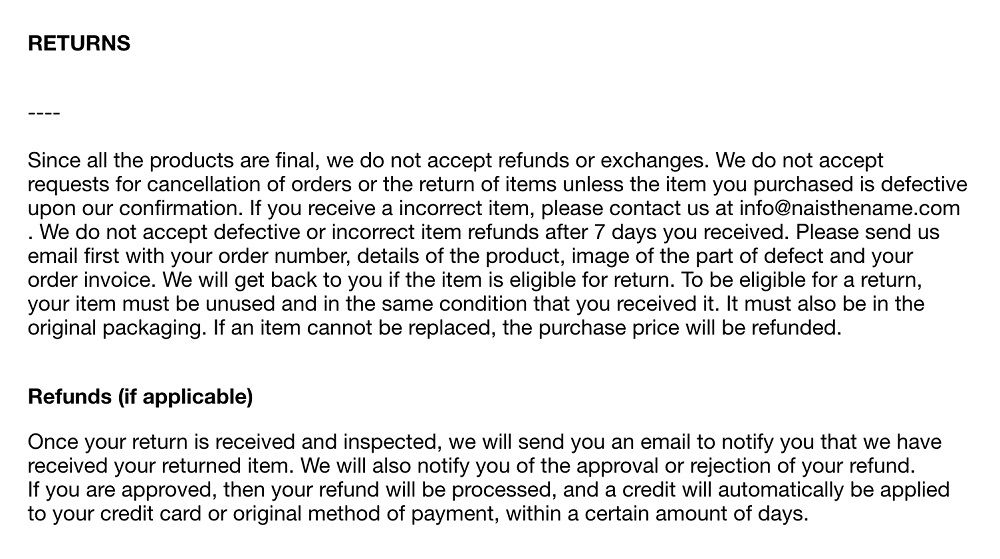
RETURNS
Since all the products are final, we do not accept refunds or exchanges. We do not accept requests for cancellation of orders or the return of items unless the item you purchased is defective upon our confirmation. If you receive a incorrect item, please contact us at [email protected] . We do not accept defective or incorrect item refunds after 7 days you received. Please send us email first with your order number, details of the product, image of the part of defect and your order invoice. We will get back to you if the item is eligible for return. To be eligible for a return, your item must be unused and in the same condition that you received it. It must also be in the original packaging. If an item cannot be replaced, the purchase price will be refunded.
Refunds (if applicable)
Once your return is received and inspected, we will send you an email to notify you that we have received your returned item. We will also notify you of the approval or rejection of your refund.
If you are approved, then your refund will be processed, and a credit will automatically be applied to your credit card or original method of payment, within a certain amount of days.
Bear in mind that such a policy wouldn't be lawful in some jurisdictions, such as the EU.
Exceptions and Conditions
Many ecommerce operations offer a more generous Return and Refund Policy than is required by law, but there will almost always be some restrictions on what will be refunded. It's important that you are clear about any restrictions and conditions.
You need to state:
- Which products are covered by your policy
- The period for which products can be returned
- Any requirement that the products are unopened or in good condition
For example, here's how you can outline exceptions and additional details:

Failing to be clear about the exceptions to your Return and Refund Policy could lead to disputes with your customers.
Here's another example:

Can I return items?
If you're not totally satisfied you can return products within 365 days of purchase. Please note:
- Refunds will always be made back to the original method of purchase.
- Mattresses can only be returned if the packaging is still on and unopened (this applies to online ordering as well*). We do understand that you may need to try a mattress first, so you may exchange it once within the first 90 days under our Love it or exchange it offer.
- You can return any items that have been assembled, as long as you have the original receipt and the item is in a re-saleable condition.
We have several different ways you can return products to us. For full details please view our Return Policy
*Under the Consumer Contracts Regulation items cannot be returned which are unsuitable for return due to hygiene reasons after being unsealed.
Any conditions that you place on returns need to be detailed in your Return and Refund Policy. For example, this Return Policy notes that sometimes requires that customers verify themselves in order to use merchandise credit that has resulted from a refund:

Return Policy
Our customers continue to be our top priority. If you're not satisfied with your purchase, return the merchandise accompanied by a register receipt within 30 days of purchase for an exchange or refund in the original form of tender. A 10-day period is required for a cash refund on check purchases. Returns with a receipt over 30 days, with a gift receipt or without a receipt will receive merchandise credit only. Merchandise credits are subject to the Terms and Conditions printed thereon and imposed by the issuer which may include restrictions on transfers.
Merchandise that is used, worn or in unsellable condition will not be accepted for refund, merchandise credit or exchange. Returns of swimwear and intimate apparel require tickets properly attached to the merchandise. Other restrictions may apply.
Unfortunately, many retailers are subject to fraudulent return activity. Returns may also be limited or declined based upon our refund verification systems, which are used to process and track returns to help administer our loss prevention program.
A valid government issued photo ID, name, address, and signature are required for non-receipted returns and may be required for use of the resulting merchandise credit. Any name printed on the merchandise credit must match the name on the photo ID presented or the merchandise credit may not be used. A customer signature may also be required for receipted returns. To learn about how we use and handle your information, please see our Privacy Notice.
To make your returns quicker and easier please keep your receipt.
If you charge a restocking fee on certain refunds, you'll also have to make this clear in your policy.
Here's an example:

OUR REFUNDS POLICY
Changed your mind?
If you've changed your mind about accessories after you've received them, that's fine. Just return them to us in their original packaging and in perfect resaleable condition within 30 days of delivery of your order and we'll refund you in full, less a restocking fee of 10% or a minimum of £10, whichever's greater. No delivery charges (including any premium delivery charges) will be refunded.
Instructions for Making a Return
You should give details of how your customers can make a return.
Here's an example of a creative method which allows for a business to absorb shipping costs for the customer:
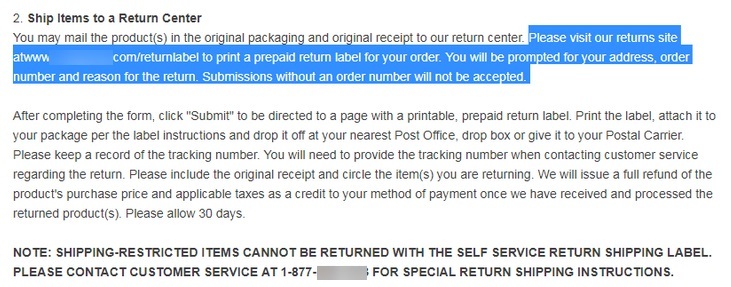
Refunds are usually made to the customer's original payment method. This can be surprisingly complicated, depending on which payment methods you allow customers to use.
Here's an example of how you can handle this:

You must warn your customers if you expect them to take on any costs associated with returning a product. For example, if there's a restocking fee or if they must pay for return shipping.
Here's an example of this:

It's a good idea to let your customers know how long a refund will take. Bear in mind that there are regulations on this in some jurisdictions.
Here's how you can do this:

You should be clear about any instances in which you're only willing to offer a partial refund.
Here's an example of such a clause:

Where to Display Your Return and Refund Policy on Your Website
As mentioned previously, it's always a good idea to refer to your Return and Refund Policy in your Terms and Conditions. It's also crucial that you post it clearly, for two reasons:
-
Your Return and Refund Policy will reassure customers about making a purchase. If they know that they're protected, they'll be more likely to buy from you.
-
Wherever refunds are regulated by law, there is often a legal obligation to post a Return and Refund Policy conspicuously. A failure to do this may mean that the policy doesn't take effect.
On Your Website
Often a business will link to its Return and Refund Policy in its footer so that customers are able to access the policy on any page.
Here's an example from Amazon:
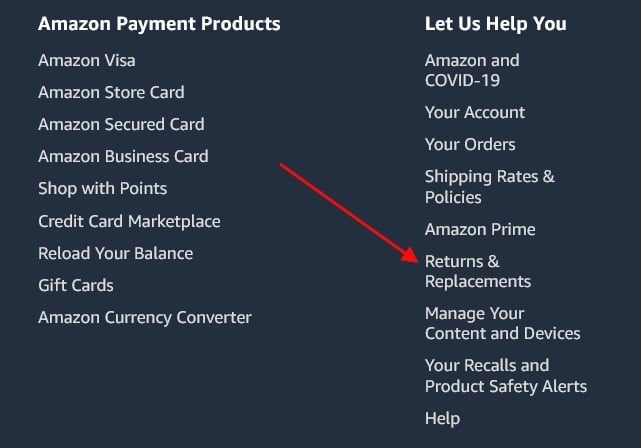
Customers really like to see this policy, so companies often display it front-and-center. You can add something like the notice below to your website header so people will know right away that you have a great perk like free returns on all orders:
![]()
On a Mobile App
Think of the "Buy now" button as your mobile app's cash register. Make sure you give your customers a chance to review your Return and Refund Policy right before they part with any money.
Here's how Amazon handles this:

The policy should also be available in the About or Help page of your app. Here's an example from the Kindle app:
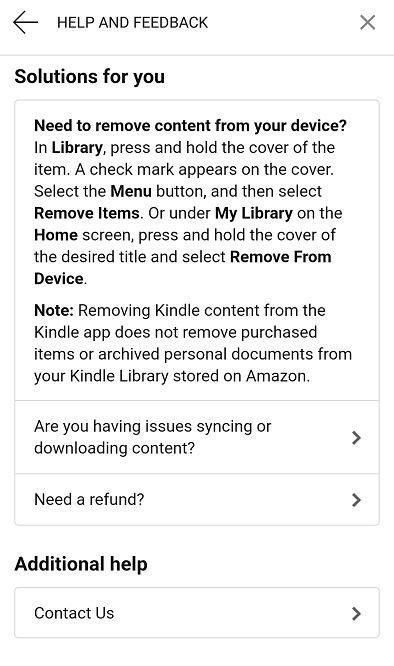
Other Locations
Many companies very clearly connect their Return and Refund Policy in their Terms and Conditions like in the example below:
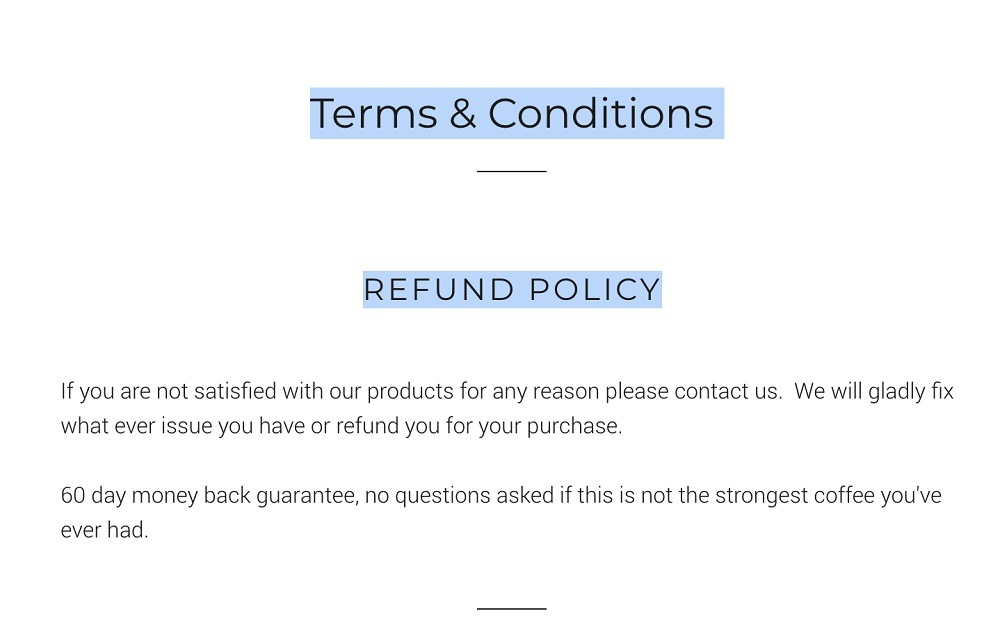
Terms & Conditions
REFUND POLICY
If you are not satisfied with our products for any reason please contact us. We will gladly fix what ever issue you have or refund you for your purchase.
60 day money back guarantee, no questions asked if this is not the strongest coffee you've ever had.
You should also provide a link to your Return and Refund Policy in confirmation emails. Here's an example:
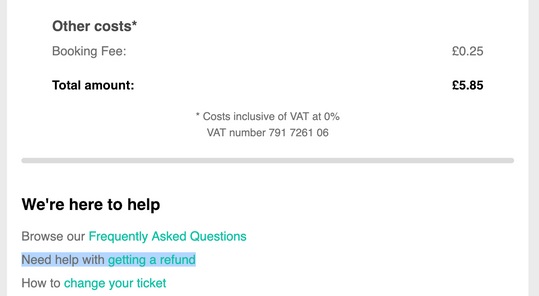
Your Return and Refund Policy is a great example of how you can use legal agreements to bring great commercial benefit to your company, and provide a great service to your customers. Just make sure that they read it!
Case Study
Sara's Sandwiches sells sandwiches and sandwich-making equipment. It runs a small store in New York, and an ecommerce store selling both food and non-food items. It serves customers all across North America and the EU.
Sara's Sandwiches wants to offer a full refund on items returned within 30 days, and an exchange or merchandise credit on any items returned within 60 days. Proof of purchase is required, and the policy doesn't cover food items.
Customers can arrange for a refund by sending their products back via post, or returning the item in-store. Customers must pay shipping for their return.
In addition to its Privacy Policy and Terms and Conditions, Sara's Sandwiches should write a Return and Refund Policy that:
- Is conspicuously posted on its website, in emails to customers, and incorporated into its Terms and Conditions
- Makes its policy clear, setting out which items will be refunded and what won't
- Provides the timeframes within which items must be returned
- Gives instructions on how to make a return
- Informs customers that refunds will be made to their original payment method
- Makes it clear that customers must pay for shipping
